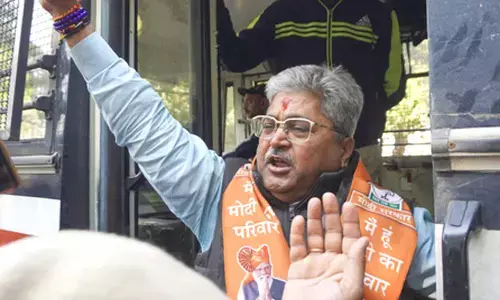India can emerge alternative to China for chipmaking cos

As per Hong Kong-based Counterpoint Technology Market Research, India’s semiconductor-related market will reach $64 billion in 2026, nearly triple the size in 2019. In March, Prime Minister Narendra Modi laid the foundation stone of three semiconductor projects worth Rs 1.25 lakh crore
New Delhi: As India aims to reach $300 billion electronics production by FY26, it will trigger demand for semiconductors worth $90-$100 billion, largely driven by domestic mobile manufacturing -- an opportunity the country must tap. The chipmaking equipment industry is looking to establish operations in India, as the country emerges as a promising alternative to Chinaamid tensions between Beijing and the West.
The international chip industry group SEMI is set to host its Semicon exhibition in India for the first time in September. This exhibition has previously been held in the US, Japan, Europe, Taiwan, South Korea, China, and Southeast Asia, reports Nikkei Asia.
Several Japanese companies, including Tokyo Electron, Disco, Canon, Tokyo Seimitsu and Daifuku are scheduled to attend. Tokyo Electron will showcase equipment for wafer deposition, coating and other front-end steps in the chipmaking process.
Additionally, US-based companies such as Applied Materials, Lam Research and KLA will also have large booths at the exhibition. In recent years, due to tensions with the US, there has been a shift in international supply chains away from China. Apple is relocating the production of iPhones and other products from China to India.
In March, Prime Minister Narendra Modi laid the foundation stone of three semiconductor projects worth Rs 1.25 lakh crore. The chip fabrication facility at the Dholera Special Investment Region (DSIR) in Gujarat is being set up by Tata Electronics Private Limited (TEPL) with a total investment of more than Rs 91,000 crore.
The Outsourced Semiconductor Assembly and Test (OSAT) facility in Morigaon, Assam is being set up by TEPL for Semiconductor Assembly, Testing, Marking and Packaging (ATMP), with a total investment of about Rs 27,000 crore. In April, Union Railways and IT Minister Ashwini Vaishnaw said that India has commissioned four semiconductor manufacturing units and in the next five years, the country will become one of the biggest semiconductor hubs in the world. As per Hong Kong-based Counterpoint Technology Market Research, India’s semiconductor-related market will reach $64 billion in 2026, nearly triple the size in 2019.
Meanwhile, it is estimated that the country will require 2.5 lakh-3 lakh skilled professionals by 2027 across Research and Development (R&D), design, manufacturing and advanced packaging domains, a report showed.
De-risking initiatives by the world’s leading electronic manufacturers, coupled with targeted government initiatives and India’s talent pool, have led the country to occupy a key position in the global semiconductor manufacturing space, according to the report by TeamLease Degree Apprenticeship. The current electronics manufacturing at nearly $103 billion translates to a semiconductor requirement of $26-$31 billion, considering the industry average of 25 to 30 per cent of chip components in any electronics product’s bill of material (BOM).
Expected to become a $100 billion industry by 2030, the expansion is poised to generate approximately 1 million global jobs by 2025–2026, aligning with India’s broader economic and industrial growth objectives. The Electronics Sector Skill Council (ESSC) currently offers over 35 apprenticeship courses under the National Apprenticeship Promotion Scheme (NAPS) scheme to address skill shortages at various levels of entry-level work.
Ramesh Alluri Reddy, CEO of TeamLease Degree Apprenticeship, emphasised upon the need to increase employment in India, especially in light of the $15 billion investment in three semiconductor plants. This investment results from the India Semiconductor Mission (ISM) and the Production Linked Incentive (PLI) scheme. The PLI scheme, in particular, offers a $1.7 billion incentive package for companies establishing semiconductor manufacturing facilities in the country. (Agencies)














